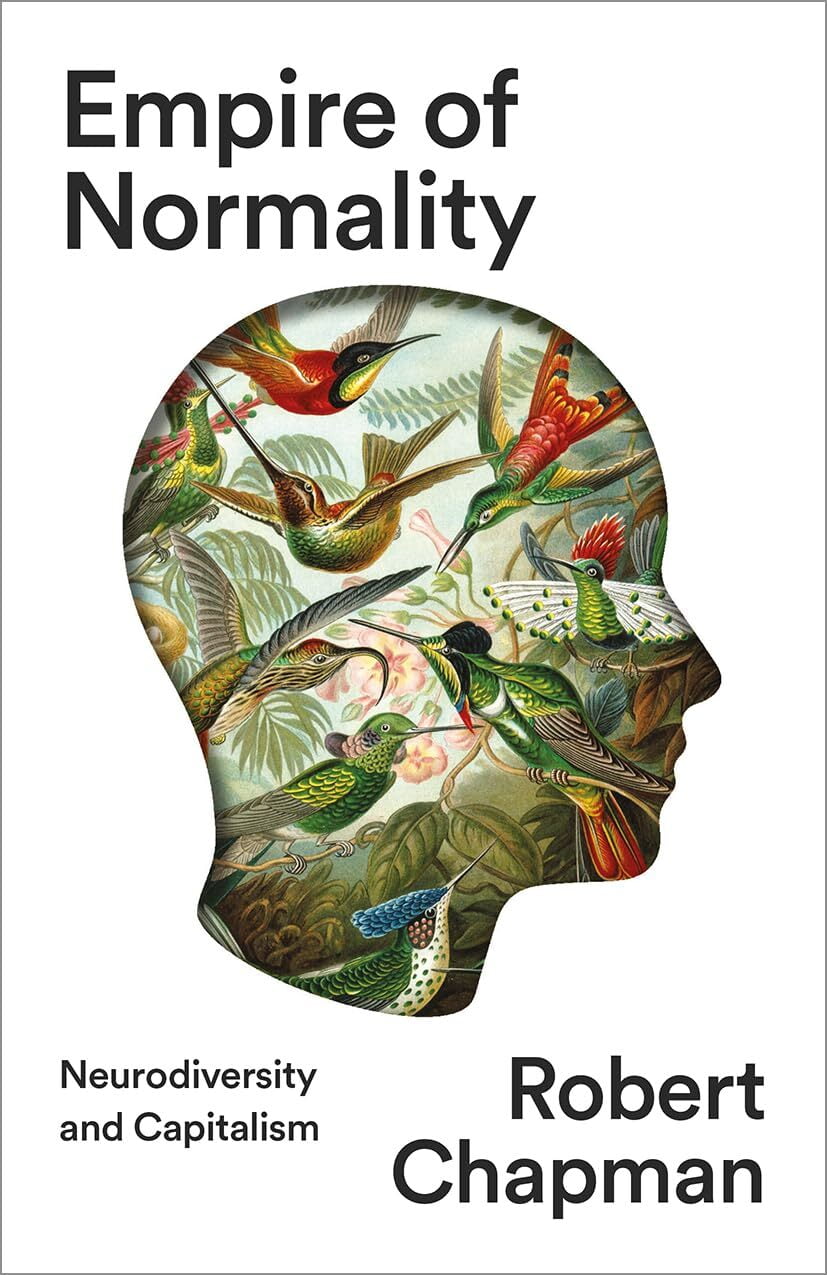Empire of Normality. Neurodiversity and Capitalism, Robert Chapman

Review by Lisanne Meinen
Increasingly, atypical cognitive functioning is perceived as a source of pride and a means for community-building, rather than as something shameful or to be fixed. This is all mainly due to the efforts and theory of the growing neurodiversity movement, which began within the online autism community in the 1990s, and has recently become more established. Different from the anti-psychiatry movement in the 1960s and 1970s, medication and therapy for experienced difficulties are not seen as something to be avoided, but rather destigmatized. Sometimes 'neurodivergent' seems to become a new identity category, just like 'queer' or any other LGBTQI+ identity marker. Especially young people are making connections through social media (TikTok, Instagram) by openly identifying themselves as autistic, ADHDer or Tourettic. Together with increased awareness, the number of people receiving a (desired) psychiatric diagnosis is growing. This development also provokes semi-critical statements about “everyone having something” these days.
These kinds of critical statements are reminiscent of anti-psychiatric thinking. Instead of the malpractices of coercion in psychiatric institutions, criticisms now target the influence of social media on our experience of the self and practices of self-diagnosis. Still, the same kind of underlying critique can be observed: to what extent are these diagnoses (biologically) ‘real’? There is something wry in these kinds of statements because while it is crucial to acknowledge societal influences on our mental well-being and resist individualizing tendencies, it also brings the risk of denying one's struggles and desired support. Can psychological vulnerability or mental illness be simultaneously something that is (partially) socially induced, but also something true?
Robert Chapman’s (they/them) Empire of Normality offers many useful answers to and beyond these questions. For Chapman, the recently developing neurodiversity paradigm offers a strong alternative to both the pathology paradigm (specifically the default labeling and treatment of psychological distress) and the anti-psychiatry movement (specifically the denial of mental illness as a phenomenon). Chapman proposes that a neurodiversity lens should always go hand in hand with an anti-capitalist critique, since one of the main struggles nowadays is precisely the mutual reinforcement of the pathology paradigm and capitalist logics.
Chapman traces the historical development of neuronormative thinking with the explicit aim of contributing to the project of neurodivergent liberation. As such, they also offer a materialist analysis of the status of normality and disability within advanced capitalism. For Chapman, the uniting force of the neurodiversity movement does not come from people sharing specific diagnoses, but rather from sharing the experience of differing from (neurological) norms that are pervasive in society. One of the starting points of Chapmans analysis, is the experience of disablement as a state that affects everyone in various ways and thus holds the possibility to unite everyone under capitalism.
Chapman’s work makes three main contributions. First, they trace the intellectual history of the pathology paradigm and its critics. The most common critique of the pathologization of mental illness can be found with anti-psychiatry thinkers. However, their ideas are unsatisfactory for Chapman for several reasons. As such, the second contribution of Chapman’s work is a strong and useful critique of the individualizing tendencies in the anti-psychiatry movement. A final contribution is the grounding of existing neurodiversity theory in an explicitly political and historical materialist analysis. This framing opens up new possibilities, for example, to criticize how neurodiversity-affirming language is increasingly taken up by e.g. employers looking for ‘special skills’ without adequately addressing the needs of their neurodivergent employees. I will now explore each of these contributions in further detail.
Chapman writes a social and materialist history of the pathology paradigm, tracing some key thinkers and their positioning in the broader material context. This is not an intellectual history guided by the ‘great men’ of the past. Rather, Chapman aims to show how the key ideologies that these thinkers represented continually interacted with and were reinforced by material conditions. Through Descartes, founder of eugenics Francis Galton, and father of psychiatry Emil Kraepelin, Chapman traces how ideas on normality became naturalized.
The combination of a Cartesian mechanistic understanding of the bodymind, the development of statistical notions of normality, and finally the idea that ‘abnormality’ was something that could be treated, led to the large-scale pathologizing of atypical cognitive functioning, Chapman maintains. Equilibrium conceptions of health as harmony within an individual or between an individual and their environment were slowly replaced with views of health as (statistical) normality. As such, Chapman demonstrates how scientific knowledge production as we know it was complicit in the development of the pathology paradigm.
After this discussion, Chapman arrives at the group of rogue psychiatrists and social theorists who challenged psychiatric pathologization in the 1960s and 1970s. Chapman is especially critical of Thomas Szasz, because although he was rightly critical of how psychiatry had been legitimized as a form of state control, Szasz did not critique the concept of biological or neurological normality itself. In Szasz’s view, behavior could still be judged as abnormal, but it had no medical cause and so it should not be medically treated. Szasz’s uncritical acceptance of the ‘normal’ body as an objectively grounded phenomenon led, according to Chapman, to a wrong conceptualization of somatic medicine as value-neutral.
Besides a critical discussion of anti-psychiatry, Chapman also convincingly discusses the politics of anti-psychiatry. In Szasz’s libertarian framework that denied the existence of any kind of mental illness as medical condition or disability at all, it was not possible for individuals experiencing difficulties to get validation or professional support. Chapman juxtaposes Szasz against Italian anti-fascist psychiatrist Franco Basaglia, who was also critical of the mistreatment of patients in psychiatric institutions at the time, but argued for acknowledging the fact of mental illness and better support at the same time. In general, the anti-psychiatry movement (with exceptions like Basaglia) did not offer a suitable alternative for patients discharged from asylums, which often led them to be moved to prisons and nursing homes instead, effectively enabling a shift from one carceral system to another.
Beside Szasz and his contemporaries, Chapman is also dissatisfied with Marxist analyses of mental health that were almost exclusively grounded in the anti-psychiatry tradition. For example, more leftist anti-psychiatrists like R.D. Laing and David Cooper offered justified critiques of psychiatry as a form of social control, but mainly uncritically adopted Szasz’s theory of mental illness as an illusion. This theory was highly individualizing and did not help people experiencing psychiatric disablement at all. As such, Chapman’s proposal of a neurodivergent Marxism aims to challenge both liberal neurodiversity approaches as well as orthodox Marxism.
A neurodiversity-informed materialist analysis, Chapman maintains, shows how social control is a problem indeed, but conceptualizations of mental illness and psychiatric diagnoses are not the cause of this social control. The anti-psychiatry movement helped resist certain manifestations of psychiatric oppression, e.g. forced admittance to asylums, through its analysis of psychiatric social control. However, the movement also brought new grounds for a cultural denial of mental illness which, together with the rise of post-Fordist capitalism, explains why anti-psychiatry did not lead to true liberation for mad and disabled people.
In the final parts of their book, Chapman analyzes how health, normality, and productivity became conceptually blended. Chapman discusses post-Fordist or cognitive capitalism, which indicates the idea that the production of wealth increasingly takes place through cognitive and cultural labor. They discuss the phenomenon of neurodivergent disablement, indicating that an increasing number of members of the population cannot keep up with the social, communicative, and sensory processing capabilities required by this new economy. Additionally, existing forms of difficulty or disablement, which are to some extent grounded in atypical neurological development (as is for example visible with autism or ADHD), are hugely amplified by cognitive capitalism. As such, Chapman maintains, the sensory-cognitive intensification of capitalism has led to new exclusions in education or work.
Chapman stresses the need for cross-neurotype solidarity, since capitalism always has a neurological in-group and out-group, even if those boundaries continually shift. As such, neurodiversity movements under capitalism will effectively only help ‘high-functioning’ people and/or those who are already privileged in other ways. Capitalism places everyone, neurotypical as well as neurodivergent, in a ’double bind’ of either being valued as a worker and thus exploited, or being categorized as surplus and thus discriminated against. Chapman advocates for embracing politicized conceptions of mental illness rather than rejecting the recognition of mental illness as such (as happened with anti-psychiatry). They offer the examples of Frantz Fanon and his anti-racist psychiatry, the 1970s radical Sozialistisches Patientenkollektivin West Germany, and Peter Sedgwick’s Marxist emphasis on the need for alternative community organizing of mental health resources beyond the state apparatus.
Most of current neurodiversity activism, Chapman argues, is more focused on changing our thinking and attitudes towards neurodiversity, than on changing material conditions. However, we need both practices equally. Chapman’s most concrete proposal for possible improvements comes in the form of four key factors of a neurodiversity-affirmative academic practice. For neurodivergent liberation and to truly challenge the Galtonian pathology paradigm, Chapman maintains, it is vital to also change our approach to scientific research. As such, researchers should develop new methods for measurements and analysis, center neurodivergent perspectives, use social and ecological models of functioning, and work with a politicized understanding of neurodivergent disablement.
This work will become, after Nick Walker’s Neuroqueer Heresies, a seminal work in neurodiversity theory. It provides a thorough overview of the development, naturalization, and implementation of the concept of normality in psychiatry. Such a historical and theoretical overview helps to resist liberal neurodiversity perspectives and language that do not fundamentally contribute to improving the lives of all of those both closer and further away from the neurotypical norm. I very much hope that – as Chapman wishes themselves – this book will prove to be a fundamental factor in the collective project of consciousness-raising.
Lisanne Meinen, researcher in philosophy and cultural studies
Robert Chapman. Empire of Normality. Neurodiversity and Capitalism (2023). Pluto Books, more information.
